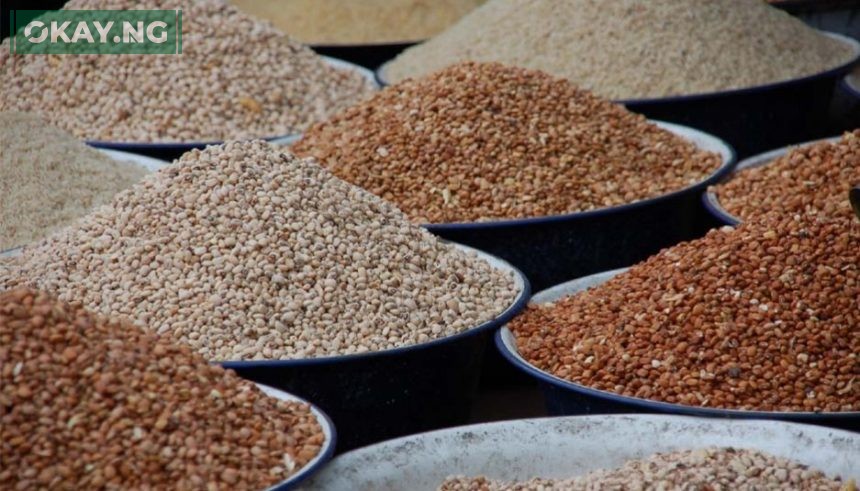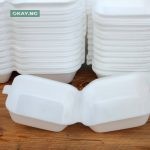The Mile 12 International Market in Lagos remains one of the most prominent hubs for the purchase of food commodities in Nigeria, including various types of beans, grains, and legumes.
Here is a detailed overview of the current prices of beans and related grains as of January 8, 2025, gathered by Okay.ng to help buyers make informed decisions.
The prices are given in Naira (₦) and include both bulk purchase (bags) and smaller retail quantities (paint buckets).
Overview of Current Prices of Beans and other Grains
As of January 8, 2025, the prices of beans and grains at Mile 12 International Market reflect the prevailing market trends, influenced by seasonal availability, transportation costs, and demand. Below are the current price ranges:
- Honey Beans (50kg bag): ₦97,000 – ₦100,000
- Brown Beans (100kg bag): ₦195,000 – ₦197,000
- White Beans (100kg bag): ₦188,000 – ₦190,000
- Local Wheat (bag): ₦153,000
- White Dawa (bag): ₦90,000 – ₦92,000
- Red Dawa (bag): ₦73,000 – ₦75,000
- Soya Beans (bag): ₦110,000 – ₦115,000
- Yellow Corn (bag): ₦75,000 – ₦78,000
- White Corn (bag): ₦70,000 – ₦73,000
Detailed Price Breakdown
1. Honey Beans
- Bag (50kg): ₦97,000 – ₦100,000
- Paint Bucket: ₦8,500 – ₦9,000
Honey beans, known for their sweet taste, remain a staple in Nigerian households. The price reflects moderate availability, with slight variations based on quality and source.
2. Brown Beans
- Bag (100kg): ₦195,000 – ₦197,000
- Paint Bucket: ₦7,500 – ₦8,000
Brown beans are widely used and highly nutritious, driving up their demand. Their price per paint bucket remains affordable for retail buyers.
3. White Beans
- Bag (100kg): ₦188,000 – ₦190,000
- Paint Bucket: ₦7,500 – ₦8,000
White beans are valued for their versatility in meals and are slightly cheaper than brown beans.
4. Local Wheat
- Bag: ₦153,000
- Paint Bucket: ₦6,800 – ₦7,000
Local wheat is essential for baking and other culinary uses, maintaining stable prices in the market.
5. White Dawa (Guinea Corn)
- Bag: ₦90,000 – ₦92,000
- Paint Bucket: ₦4,000 – ₦4,500
White dawa (guinea corn) is widely used in traditional Nigerian dishes. Its price varies slightly depending on supply.
6. Red Dawa
- Bag: ₦73,000 – ₦75,000
- Paint Bucket: ₦4,000 – ₦4,500
Red dawa is another variation of guinea corn, slightly cheaper than the white variety.
7. Soya Beans
- Bag: ₦110,000 – ₦115,000
Soya beans, essential for protein-rich diets and livestock feed, remain competitively priced.
8. Yellow Corn
- Bag: ₦75,000 – ₦78,000
- Paint Bucket: ₦3,500 – ₦3,800
Yellow corn serves both human consumption and livestock feeding, with steady demand keeping prices consistent.
9. White Corn
- Bag: ₦70,000 – ₦73,000
- Paint Bucket: ₦3,000 – ₦3,500
White corn is slightly cheaper than yellow corn, making it a popular choice for buyers.
Factors Influencing Prices
The prices of beans and grains are influenced by several factors, including:
- Seasonal Availability: Harvest seasons typically lower prices, while off-season periods lead to price increases.
- Transportation Costs: Rising fuel prices and logistics challenges can significantly impact the cost of goods.
- Demand: High demand for certain types of beans and grains, especially during festive seasons, often drives up prices.
- Quality: Premium-quality produce tends to be more expensive than lower-grade varieties.
Summary Table of Current Prices
| Item | Bag Price (₦) | Paint Bucket Price (₦) |
|---|---|---|
| Honey Beans (50kg) | ₦97,000 – ₦100,000 | ₦8,500 – ₦9,000 |
| Brown Beans (100kg) | ₦195,000 – ₦197,000 | ₦7,500 – ₦8,000 |
| White Beans (100kg) | ₦188,000 – ₦190,000 | ₦7,500 – ₦8,000 |
| Local Wheat | ₦153,000 | ₦6,800 – ₦7,000 |
| White Dawa | ₦90,000 – ₦92,000 | ₦4,000 – ₦4,500 |
| Red Dawa | ₦73,000 – ₦75,000 | ₦4,000 – ₦4,500 |
| Soya Beans | ₦110,000 – ₦115,000 | Not available |
| Yellow Corn | ₦75,000 – ₦78,000 | ₦3,500 – ₦3,800 |
| White Corn | ₦70,000 – ₦73,000 | ₦3,000 – ₦3,500 |
Tips for Buyers
- Buy in Bulk: Purchasing larger quantities (e.g., 50kg or 100kg bags) often comes with better pricing.
- Inspect Quality: Always inspect the grains to ensure they are free from pests and of good quality.
- Negotiate Prices: Vendors may be willing to reduce prices for bulk purchases.
- Shop Early: Visit the market early in the day for the best selection and freshest produce.
- Consider Seasonal Trends: If possible, purchase during harvest seasons when prices are typically lower.













